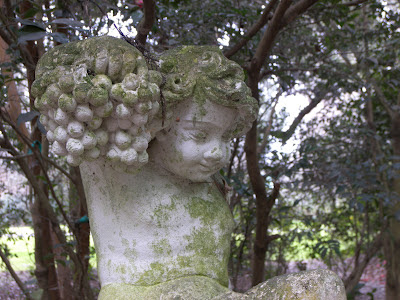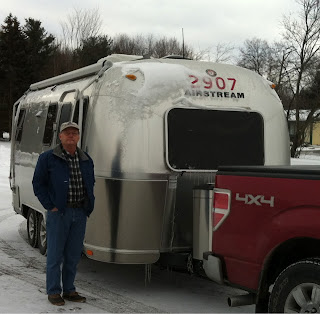We spent Sunday driving from the Abbeville, SC area to Charleston, SC. It was a rainy and cool day, so although we had planned a stop at the Redcliff Plantation (
http://south-carolina-plantations.com/aiken/redcliffe.html), the clay road leading to the Plantation was narrow and muddy, so we decided against risking getting the camper stuck in the muck and just pushed on. When we reached our destination campground, James Island County Park, the sun had come out and we were assigned a pretty site along the outside edge of the park; as we began situating the trailer, the skies opened and we had a massive downpour, which put us both back in the truck to wait it out. This turned out to be a blessing in disguise, because 20 min. later when the rain stopped, we found that 3/4 of our campsite was submerged in 2-3 inches of water - a literal lake! We drove around the extremely soggy campground and picked out a couple of other potential sites which had remained relatively dry during the downpour, indicating higher ground, and were able to switch to a very nice site which is actually roomier and prettier than the one was that had been originally assigned to us. This is a very nice county park with full hookups (water, electricity, sewer, wi-fi), very clean and well-maintained and relatively close to downtown Charleston.

This campground offers a shuttle service into Charleston, which we took advantage of on Monday. We left the campground at 9am and returned about 4:15. When we first arrived at the visitor's center in Charleston, we purchased a brochure to a self-guided walking tour of the historic district and then started out. Spent the whole day walking and enjoying the ambience of this old (by US standards) city. Obviously, we did not see or experience the whole city, just sections of the historic district, but that was lovely!
We visited two very different mansions in the city: the Nathaniel Russell House at 51 Meeting Street (
http://www.historiccharleston.org/experience/nrh/ ) and the Aiken-Rhett House at 48 Elizabeth Street (
http://www.historiccharleston.org/experience/arh/ ). The Russell House has been restored to its former glory, with great pains taken to research and duplicate exactly the paint and furnishings of the house during the 1800's at the height of its glory. The interpreters who lead small groups through the home are well versed in the history, architecture, and furnishings of the time, and provide an intriguing introduction to the home and the efforts undertaken in its restoration to date as well as plans for future restoration and the problems and challenges those plans present. This home has a 3-story self-supporting spiral staircase, which is an incredible feat of architecture for that time; unfortunately future restoration plans include building a different staircase for tourist use to minimize wear and tear on this beautiful staircase, but we were fortunate to still be able to take that staircase, walking the same worn treads as the previous inhabitants. No photography was allowed in the interior of either of these mansions, so the only photos I will include will be of the exteriors, but those are actually quite representative of the current state of the two homes.
Nathaniel Russell House:
We had a great late seafood lunch (oyster po-boy for John and a shrimp/crab sandwich for Liga) and then went on to explore the Aiken-Rhett House. This mansion from the same period is unusual in that subsequent owners kept intact the detached slave quarters, carriage house and stables, and the outbuildings (not true for the Nathaniel Russell House, where only the house and detached kitchen remain intact, although the gardens surrounding the house have been restored and are beautiful. The Aiken-Rhett House offers a self-guided tour using earphones and a tape that describes the history and the current state of the house as it walks you through the estate. This house could easily be inhabited by Miss Havisham (
http://en.wikipedia.org/wiki/Miss_Havisham ), with the ruined and dusty furnishings and wallpaper peeling in long strips from the walls. Surprisingly, the home was occupied until being turned over to the city historical society in the late 1970's, but apparently these subsequent occupants of the home closed off an ever-increasing number of the grand old rooms and lived in just a few core rooms in the dwelling, leaving the rest to gradually age and crumble.
Aiken-Rhett House:
We ended our sunny but cool day of walking and exploring, pleasantly tired and intrigued, looking forward to experiencing more of the history of this city.
 Since Nancy and Lynn had seen the interior of the plantation house not long ago on an earlier trip to Charleston, we skipped going in and just spent hours wandering the various gardens, something that was beautiful even though the spring blossom season is still a few weeks away; still enough camellias and daffodils as well as some early azaleas, redbud, cherry and a few other plants were displaying early blooms to give us a foretaste of what these gardens will offer in a few weeks.
Since Nancy and Lynn had seen the interior of the plantation house not long ago on an earlier trip to Charleston, we skipped going in and just spent hours wandering the various gardens, something that was beautiful even though the spring blossom season is still a few weeks away; still enough camellias and daffodils as well as some early azaleas, redbud, cherry and a few other plants were displaying early blooms to give us a foretaste of what these gardens will offer in a few weeks. 























